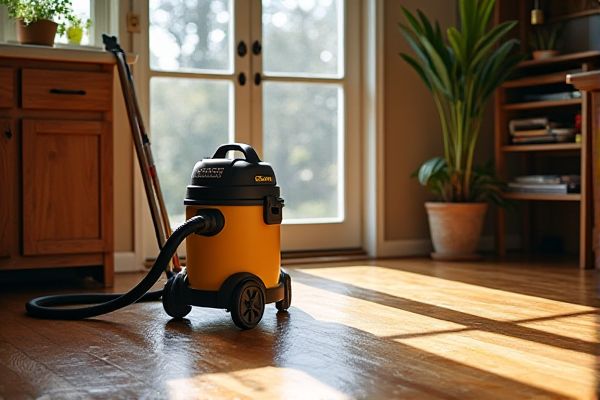
A shop vac and a wet/dry vacuum both offer powerful suction for cleaning debris, but a wet/dry vacuum is specifically designed to handle liquids as well as solids, making it more versatile for various tasks. Explore this article to discover which vacuum suits Your cleaning needs best.
Table of Comparison
| Feature | Shop Vac | Wet/Dry Vacuum |
|---|---|---|
| Primary Use | Heavy-duty debris, dust, and liquid cleanup | Versatile for both wet spills and dry debris |
| Motor Power | Typically 4-6 peak HP | Ranges from 3 to 7 HP, depending on model |
| Capacity | Usually 4 to 16 gallons | Typically 5 to 20 gallons |
| Filtration System | Standard foam or cartridge filters for dust | Advanced filters with HEPA options available |
| Portability | Usually heavy, designed for stationary use | Often features wheels and handles for easy movement |
| Price Range | $50 - $250 depending on brand and features | $70 - $400 depending on size and capabilities |
| Ideal For | Workshops, construction debris, water spills | Garages, basements, flood cleanup, dry debris |
Introduction: Shop Vac vs Wet/Dry Vacuum
Shop Vac and wet/dry vacuum both excel in handling heavy-duty cleaning tasks, but the Shop Vac is often recognized as a brand name synonymous with durability and powerful suction ideal for construction debris and large spills. Wet/dry vacuums offer versatile functionality by effectively managing both liquid and solid messes, making them essential for workshops, garages, and home cleaning projects. Your choice should depend on specific cleaning needs, considering factors like capacity, suction power, and portability.
What Is a Shop Vac?
A Shop Vac is a powerful, versatile vacuum designed for heavy-duty cleaning tasks in workshops, garages, or construction sites, capable of handling both wet and dry debris. Unlike standard vacuums, it features a robust motor, a large capacity tank, and specialized filters to efficiently manage dust, sawdust, liquids, and larger debris. Your choice of a Shop Vac ensures effective cleanup of tough messes that typical household vacuums cannot handle.
What Is a Wet/Dry Vacuum?
A wet/dry vacuum is a versatile cleaning tool designed to handle both liquid spills and dry debris, making it ideal for heavy-duty tasks in workshops, garages, and construction sites. Unlike regular shop vacs that primarily focus on dry materials, wet/dry vacuums feature specialized filters and seals to safely collect water, mud, and other liquids without damaging the motor. Your choice between a shop vac and a wet/dry vacuum depends on whether you need a dual-function device capable of tackling both wet messes and dry dust efficiently.
Key Differences Between Shop Vac and Wet/Dry Vacuum
Shop vacs are specifically designed for heavy-duty debris and liquid cleanup, featuring powerful suction and large capacity tanks ideal for construction sites and workshops. Wet/dry vacuums offer versatile functionality, handling both wet spills and dry debris with washable filters and multiple attachments for household and commercial use. Your choice depends on the cleaning tasks; shop vacs excel in industrial environments while wet/dry vacuums provide practical solutions for diverse cleaning needs.
Performance Comparison: Power and Suction
Shop vacs typically offer higher power and stronger suction compared to standard wet/dry vacuums, making them ideal for heavy-duty cleaning tasks involving debris, liquids, and fine dust. Wet/dry vacuums provide versatile suction suitable for home use, but may lack the consistent power and durability required for industrial or prolonged use. Choosing the right vacuum depends on your specific needs for suction strength and the types of materials you intend to clean.
Versatility and Applications
Shop vacs and wet/dry vacuums both offer exceptional versatility, with shop vacs excelling in heavy-duty debris removal such as wood chips and large dust particles. Wet/dry vacuums provide broader applications by handling liquids, fine dust, and dry debris, making them ideal for workshops, construction sites, and household spills. Your choice should depend on the specific tasks you need to tackle, as wet/dry vacuums generally deliver more multifunctional use across various cleaning scenarios.
Filtration Systems and Dust Management
Shop vacs and wet/dry vacuums feature advanced filtration systems designed to capture fine dust and debris, reducing airborne particles for cleaner air quality. High-efficiency HEPA filters are commonly used in both types to trap microscopic dust, enhancing dust management during heavy-duty cleaning tasks. You can optimize performance by selecting a wet/dry vacuum with a sealed filtration system that prevents dust leakage and ensures efficient debris containment.
Ease of Use and Maneuverability
Shop vacs and wet/dry vacuums are designed for heavy-duty cleaning but differ in ease of use and maneuverability. Wet/dry vacuums often feature lightweight designs and swivel casters, making them easier to maneuver around tight spaces, while shop vacs typically have bulkier builds that may require more effort to transport. Your choice should consider the size and weight of the vacuum for efficient handling during various cleaning tasks.
Maintenance and Durability
Shop vacuums require regular filter cleaning and occasional hose inspections to maintain optimal suction performance, with durable constructions designed for heavy-duty use in workshops. Wet/dry vacuums feature robust motor seals and corrosion-resistant components to handle liquid spills efficiently, reducing the risk of damage from moisture exposure. Both types benefit from routine emptying and proper storage to extend lifespan and ensure reliable operation under various cleaning conditions.
Which Is Right For You? Choosing Based on Your Needs
Shop vacs and wet/dry vacuums both handle liquid and solid debris, but your choice depends on specific cleaning tasks and environment. Shop vacs excel in heavy-duty debris removal and are ideal for workshops or construction sites, while wet/dry vacuums offer versatility for household spills and general cleaning. Assess your cleaning frequency, debris type, and portability needs to determine which vacuum best suits your maintenance routine.
 homyna.com
homyna.com